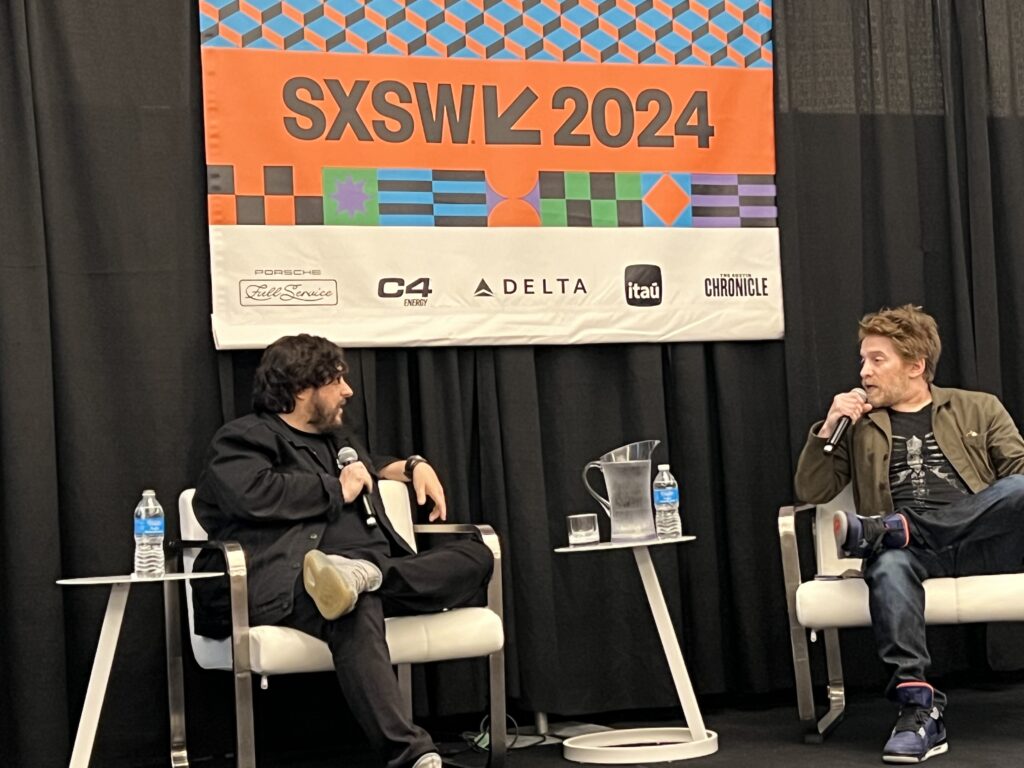
Most people separate de-extinction from species preservation, said Ben Lamm, Colossal Biosciences Co-founder and CEO.
“But the problem is that conservation works. It just doesn’t work as fast as we need it to, and how fast we are destroying the planet,” Lamm said.
He said de-extinction is a way to look at a systems problem rather than just preserving land or stopping poaching.
“We have to invent crazy technology that we can bring back animals that we are losing every single year,” Lamm said. “I think it’s pretty important for us to have a de-extinction toolkit and not need it rather than not have a de-extinction toolkit and need it.”
Lamm spoke Friday afternoon at South by Southwest in a session titled “How the Science of De-Extinction is Helping to Save Species.” Actor Seth Green interviewed Lamm. The talk was similar to one he gave at SXSW in 2023. Still, the company has had some scientific breakthroughs since then and hired a documentary film crew to film the process from lab to rewilding extinct species like the Woolly Mammoth, Thylacine, and Dodo Birds back to their natural habitats.
Colossal Biosciences, founded in 2021, has raised $235.5 million to de-extinct species. Lamm founded the company with George Church, a Harvard geneticist and pioneer in personal genomics and synthetic biology. Colossal also spun out Form Bio, a software platform, which raised $30 million. The company is based in Dallas but has offices in Austin, Boston, Santa Cruz, California, and Melbourne, Australia.
Lamm said Colossal is building technologies and tools behind de-extinction that create a higher framework that all conservationists can use. He said no research and development dollars are going into the conservation category, so everything Colossal does is free to that community.
To that point, this week, Colossal Biosciences announced that their Woolly Mammoth team had achieved the first global induced pluripotent stem cell breakthrough.
The IPSC cells represent a single-cell source that can propagate indefinitely and give rise to every other cell type in a body. According to the company, the IPSCs extend far beyond this de-extinction project and hold tremendous potential for studying cell development, cell therapy, drug screening, and synthetic embryos.
Lamm said this allows Colossal to take stem cells, perform a fundamental process, and turn them into new products.
He said, “We can make unlimited numbers of rhino heads and never have to put that animal at risk.”
Lamm said early critics of Colossal’s research are beginning to see its benefits. The company publishes everything it does in science papers and makes it available to other scientists.
“Everything we do is open source, Lamm said.
Green asked about the rewilding part of reintroducing Woolly mammoths, Thylacines, and Dodo Birds back into the environment, which are the three species Colossal Biosciences is working on.
Colossal Biosciences will not be able to change the environment overnight, but these species can restore pieces that have been removed from the ecosystem and add incredible biodiversity, Lamm said. For example, Yellowstone reintroduced wolves in the national park, and Lamm said the rewilding experience had been highly successful.
Lamm said Colossal plans to make about 100 Woolly Mammoths. The Mammoth embryos will be implanted into Asian elephants, serving as surrogates. The elephants share 99.6 percent of the genetic makeup of a Woolly Mammoth.
Lamm said a Colossal lab uses ex-utero embryos and engineers them to grow outside an animal.
Lamm said that eliminating an animal from the environment can have a detrimental ripple effect throughout the ecosystem.
For example, he said there used to be 50 million beavers, but now there are 5 million. If the ecosystem adds 5 million more beavers, those wetlands they create will capture more carbon than the carbon-capture air systems people spend billions of dollars on worldwide, Lamm said.
“The planet works well,” Green said. “It’s just these humans that have jacked it up.”
Lamm predicts the biodiversity economy will mature in the next ten years. Increasingly, people are putting a value on protecting animals, he said.
Man hunted the Thylacine into extinction in 1936. It was the largest apex predator. They are about the same size as a wolf at eight pounds, Lamm said. They clean up the ecosystem, he said. If you lose an apex predator, you have many sick animals, Lamm said. For example, some of the Tasmanian Devil population in Australia have legions on their faces and carry a transmissible cancer today, he said. He said that if Thylacine existed, it would have eliminated the sick animals before they became widespread and problematic.
Green asked Lamm about the ethical implications of creating tools and technology that can manipulate genetics and modify traits and the threat of eugenics.
Lamm said that genetic engineering is not allowed in the United States. But in China in 2019, a scientist used CRISPR technology to edit a set of twin girls’ genomes to prevent them from contracting HIV from their fathers.
Lamm said global regulation is needed when manipulating human genomes. He said Colossal doesn’t work on humans, only on endangered species.
Colossal recently hired James Reed, director of the Oscar-winning Netflix documentary “My Octopus Teacher,” and his company Underdog Films, to produce a multi-year docuseries. They have exclusive access to follow Colossal as it works to bring back the Woolly Mammoth, the Thylacine, and the Dodo Bird and to rewild them into their natural habitats.
